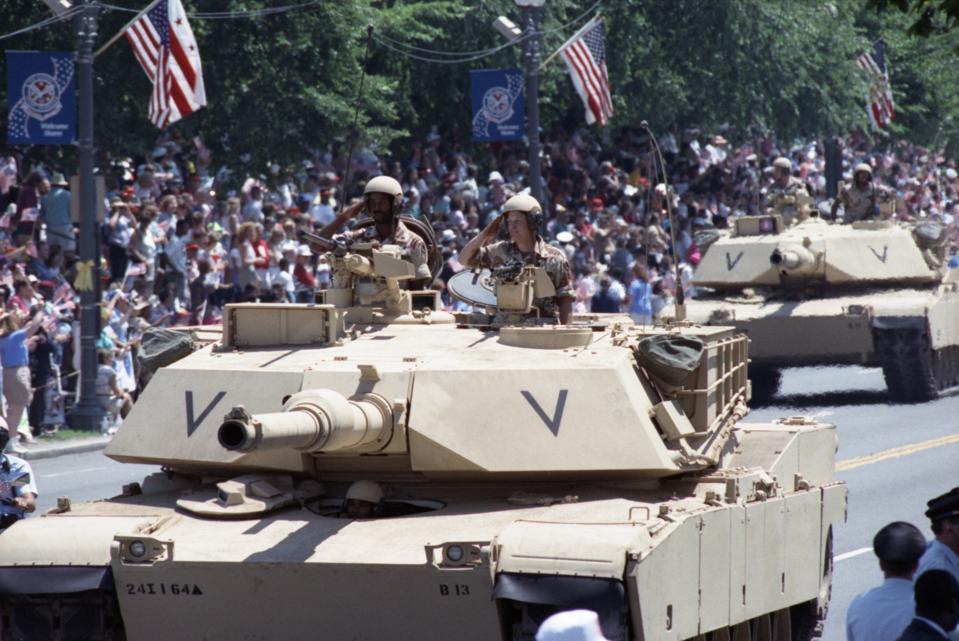Holding a large military parade in Washington, DC, featuring tanks, helicopters, and thousands of troops marching arguably lacks a certain level of grace and dignity. It is overly excessive and expensive, especially when those millions of dollars required could be spent on other, more urgent needs of the country. Furthermore, it conjures up images more commonly associated with dictatorial regimes rather than the democratic United States. And the streets of Washington were not built to have tonnes of heavy armor rolling over them.
These criticisms sound contemporary in light of President Donald Trump’s upcoming June 14 military parade, which will coincide with the 250 anniversary of the U.S. Army’s founding and, coincidentally, the president’s birthday. However, these were some of the opinions appearing in the U.S. media the last time Washington held a military parade, which took place on the very same month 34 years ago.
Trump’s characteristically ostentatious parade, which he’s wanted to do since his first term, will feature, among other things, “28 Abrams tanks, 6,700 soldiers, 50 helicopters, 34 horses, two mules and a dog,” per the New York Times. It will also feature 28 Stryker armored personnel carriers and 28 Bradley Fighting Vehicles. Even a World War II-era B-25 Mitchell bomber will participate.
The 1991 parade, dubbed the National Victory Celebration, was held on June 8, 1991, and marked the first time the capital had seen such an event since the end of the Second World War 46 years earlier. Unlike Trump’s parade, the 1991 parade honored a swift American victory in a recent war, the Persian Gulf War, which expelled Saddam Hussein’s Iraqi Army from Kuwait, which it had forcibly annexed in 1990.
With fireworks and fighter jets putting on a dazzling display overhead, approximately 10,000 U.S. troops marched in the three-hour parade led by Gulf War commander General Norman Schwarzkopf. President George H.W. Bush observed from a bulletproof reviewing stand. Abrams tanks in desert camouflage and Bradleys also rolled past cheering crowds. Even the MIM-104 Patriot air defense system, which became a household name in 1991 for its purported success intercepting Iraqi Scud missiles over Israel and Saudi Arabia, made an appearance. A total of 82 military aircraft of various types that served in the war, including the iconic F-117 Nighthawk stealth bomber, flew over Washington landmarks.
Cheered on by at least 200,000 people, the parade lasted three hours. By the end of the fireworks display later that day, at least 800,000 had gathered on each side of the Potomac River to enjoy the rare event. Not to be outdone, New York City held a parade of its own two days later featuring another fireworks display and an estimated 6,000 tons of confetti. Unlike its Washington predecessor, the New York parade did not feature any tanks trundling down the streets or military aircraft flying overhead, given the city’s ubiquitous skyscrapers.
There were minimal protests throughout the main Washington parade. Anti-war activists gave speeches in Lafayette Park, away from the parade route, but that was about it. Nevertheless, several press editorials critiqued the parade before, during, and after, using similar criticisms to those currently leveled at President Trump’s upcoming event.
One letter to the editor of the Intelligencer Journal argued that the parade lacked “grace, dignity befitting a great nation.” “Those who are inclined to support this parade might consider that its closest parallel is the old Soviet Russian May Day Parade,” the letter added. An editorial by Donald Kaul after the two parades even likened them to “Nuremberg rallies for Republicans,” adding that the sight of Americans cheering at tanks made him “feel like an Argentine.”
Critics today charge that Trump’s parade is “something that you would expect to see in countries like North Korea or the old Soviet Union or today’s Russia.”
The $12 million price tag for the 1991 parade also drew some criticism at the time, which invariably argued that the money would have been better spent on education.
Included in the $45 million overall cost of Trump’s upcoming parade is $16 million for repairing any street damage caused by the heavy tanks—the Abrams weighs approximately 70 tons. The army has already placed steel plates along the parade route to try and minimize potential damage, a measure that costs an estimated $3 million alone.
Unsurprisingly, the likely damage caused by Abrams tanks driving down Washington’s civilian streets was also an issue raised back in 1991. Ahead of the parade, engineers had to determine how many Abrams tanks the Memorial Bridge over the Potomac could safely hold without causing a collapse. They concluded it could manage one going no faster than 30 miles per hour at a time.
Doubtlessly similar calculations are being made again today.

